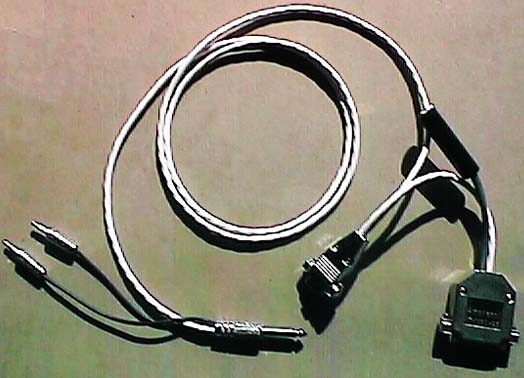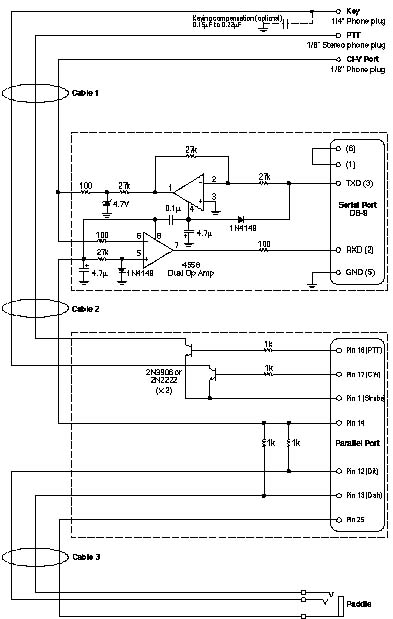
Figure 1. The completed cable assembly.


Figure 2. IC-706-to-TR-Log Cable schematic.
Bob Wolbert, K6XX
A trip was planned to Hawaii for the CQWW CW, and an IC-706 mini-HF rig was purchased. While a compromise antenna was necessary, there was no need to compromise on logging capability. TR-Log offered all the necessary features, including a memory keyer with paddle input and rig control with automatic band change monitoring--if the proper interfaces were brought. The goal of maximizing available suitcase room for antennas meant minimizing space taken for everything else. While clothing is never a problem when vacationing in KH6, the extra interface boxes and their power supplies were rather inconvenient.
Five goals were selected for an interface cable design:
· Interface the Icom rig to TR-Log software on a notebook computer
· CW keying interface with PTT control
· Serial rig control (CI-V for Icom)
· Paddle input
· Cable only (no boxes)
· No external power supplies required
With these goals in mind, all circuitry had to fit inside the connector hoods. Details on the CI-V interface is available from www.k6xx.com/radio/icbsciv.html. Details on the paddle, PTT, and keying interface are included in the TR-Log manual. This cable will work with all Icom rigs if the correct PTT connector is used.
The IC-706 VOX mode is selectable in 100ms time increments, from "0" to 1 second. The 100ms position is too slow for contest operation, and the "0" position does not operate properly: it is neither VOX nor QSK; and it distorts the occasional character, clipping dashes and eliminating dots. TR-Log's PTT output solves these problems. The IC706 is set to non-break-in mode (neither QSK nor VOX), and is placed in transmit mode by the PTT signal. The key/PTT timing is set by the logging software, and has user-configurable delay between PTT enable and the start of the first keyed element. Additionally, when using the TR-Log paddle input, a separately programmable delay between characters is available. It really works well!
The cabling between connectors is chosen so that no more than 2 multiconductor cables are fed to either hood. Ideally, the parallel port connector would have three cables fed to it, but its hood would not close with this many conductorsat least with the cable used. A daisy-chain arrangement is employed, with the Key and PTT outputs fed from the parallel port to the serial connector hood, then out again to the rear panel of the IC706. The Key output (a 1/4" phone plug) receives the cable from the serial hood containing Key, PTT, and CI-V lines. RG174 coax cable exits from the 1/4" phone plug hood to the PTT and CI-V 1/8" phone plugs. This produced the cleanest overall cabling arrangement. The PTT signal enters the IC-706 via its FSK input. This 1/8" stereo connector has FSK on the tip, ground on the ring (shaft), and PTT on the second connection.



Figure 2. IC-706-to-TR-Log Cable schematic.
Last updated 7 April 1998
Copyright ©1998, Bob Wolbert, K6XX

E-mail: Bob Wolbert, K6XX